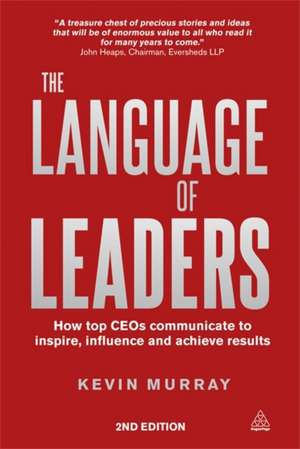The Language of Leaders – How Top CEOs Communicate to Inspire, Influence and Achieve Results
Autor Oh Ohen Limba Engleză Paperback – 2 apr 2013
Preț: 217.07 lei
Nou
Puncte Express: 326
Preț estimativ în valută:
41.55€ • 45.15$ • 34.92£
41.55€ • 45.15$ • 34.92£
Carte disponibilă
Livrare economică 31 martie-14 aprilie
Preluare comenzi: 021 569.72.76
Specificații
ISBN-13: 9780749468125
ISBN-10: 0749468122
Pagini: 288
Dimensiuni: 156 x 234 x 16 mm
Greutate: 0.41 kg
Ediția:2. Auflage.
Editura: Kogan Page
ISBN-10: 0749468122
Pagini: 288
Dimensiuni: 156 x 234 x 16 mm
Greutate: 0.41 kg
Ediția:2. Auflage.
Editura: Kogan Page
Cuprins
Foreword
Thanks
Introduction: communicate to inspire
Part One Why you need to be a better communicator if you want to lead
01 Napoleon’s leadership legacy
The shots that echo through time
‘Create leaders everywhere!’
The importance of understanding the commander’s intent
Communication is the glue that binds strategy and delivery together
Keep it simple
Free people up with a tight framework
Stand up for what you believe in
Key points from Chapter 1
02 Leadership transformed – life in the fishbowl
Perpetual communication
The questions that really matter
The new partnership driving transparency
Stories evolve at an incredible pace
Internal e-mails can be very public
Most leadership communication is not fit for purpose
Businesses are like open democracies
Leaders must create leaders
Radical transparency needs radical thinking
Key points from Chapter 2
03 The 12 principles of leadership communication
Be yourself, better
Mission and values
Future focus
Bring the outside in
Engage through conversations
Audience centricity
Listening
Point of view
Stories and anecdotes
Signals
Prepare properly for public platforms
Learn, rehearse, review, improve
Part Two The fundamentals
04 Learn to be yourself, better
What followers want from leaders
What do leaders want from the leaders they hire?
Talking from the heart
Be visible, be human and be straight
To be seen as a hero, you have to be a hero
All-round authenticity
Have the confidence to be you
Know your strengths to be yourself better
How do you go about identifying your values and mission?
A springboard to action, a leadership platform
The need for emotion in business
Key points from Chapter 4
05 Provide a framework for leadership and action, through mission and values
Values build trust
Why people love a motivating mission
Employees want a good mission statement
Employees need to feel part of the story
The need to raise people’s sights
Externally, a purpose wider than profit is needed
Be an engine of progress for humankind
Involve everyone in your mission
Reputations at risk
The need for speed and the need to create leaders
Three examples of mission and values at work
Make sure the values resonate
In the public sector, purpose and values are all-important
The value of values
Key points from Chapter 5
06 Communicate the future to drive the present
To talk about the future, you have to be very clear about the future
Back to the future, over and over
Keep people engaged in the future
Your future must embrace all stakeholders
Four examples of how leaders bring mission, values, vision and goals together
Bring to life the customer’s experience
Key points from Chapter 6
07 Bring the outside in and focus on building relationships and trust
Loss of your ‘licence to operate’
Managing the intangible asset of relationships
The virtuous circle in relationships
The real value of trust
Watch out for the reputation gap
The three dimensions of trust
Why leaders need to inject more character into their communication
The health warning on building trust
How to unlock the value in relationships
Tuning in to the court of public opinion
Get your hands dirty
If need be, actually bring the client in
The customer experience brings the vision alive
How to develop quivering antennae
But what do I do with the insights?
Key points from Chapter 7
08 Engage and align through conversations
What is an engaged employee?
Myth: ‘People are our only asset’
Engagement at the heart of strategy
Choice, not change
The ingredients of engagement
Measure and monitor engagement
Input equals buy-in
Don’t dominate the conversation
If communication is so important, where is the training?
Key points from Chapter 8
Part Three Communicate, communicate, communicate
09 It’s all about them – the need for audience centricity
It’s not what you say; it’s what they hear
What do you want them to think, feel and do?
Don’t change the message; change the way you deliver it
How audience centricity helped to establish Canary Wharf
The story of the privy
How to think about your audience
Key points from Chapter 9
10 The inspiring effect of listening leaders
Be interested, be respectful and be patient
What stops effective listening?
Listen with your eyes, ears and heart
Listen for solutions
Why leaders should be passionate about bad news
Leaders can listen in different ways
When you listen, you must respond
The killer questions leaders should ask
Good listening + a bias to action = results
Key points from Chapter 10
11 Stand up to stand out – why you need a point of view
Using a point of view to take a stand
Why you need an answer that works instantly
The corrosive effect of not taking a stand
What makes a good point of view?
Key points from Chapter 11
12 The power of stories
Stories tell us great truths
Logic gets to the brain, stories get to the heart
The difference between a story and a narrative
The four types of business stories
Good stories are easy to find and easy to tell
Choosing the right story
One simple story can achieve more than a volume of rules
Key points from Chapter 12
13 Watch out for the undermining signals beyond the words
It’s written on your face
People watch your body language too
When being visible is the message
Model the behaviours you want
The meaning between the lines
Symbolic acts send lasting messages
Speaking off the cuff
Key points from Chapter 13
14 Prepare properly for public platforms
Get the right training and do the right preparation
Remember, every word counts
Simple messages repeated often
Top tips for dealing with the media
The essence of good presentations and speeches
Communicating in a crisis
And what about the web and social media and Twitter and...?
Key points from Chapter 14
Part Four Conclusion
15 Learn, rehearse, review, improve; become fluent in the language of leaders
A top-three skill of leadership, yet sadly neglected
Strive to be an excellent communicator, and you will improve results
16 Leadership in the public sector – is it different?
Inspired by (and inspiring about) making a difference
Results of a study on differences in leadership traits
More similarities than differences
The myths of poor public sector leadership
More focus on purpose and values
Dealing with the complex relationships
The need for collaboration is driving change
17 If you remember nothing else…
18 Your cut out and keep guide to being inspiring
19 The tough questions all leaders need to ask of themselves
Are you an inspiring leader and communicator?
Meet the leaders interviewed for this book
Index
Recenzii
Praise for the previous edition:
"The radical transparency of a fast changing digital world means there has never been a more critical time for business leaders to be more inspiring communicators...the book examines how leaders must now communicate in order to inspire, influence and achieve results...[and] presents a rare insight into the leadership demands of the modern age." --Chime Communications
"...The Language of Leaders explains why leadership has changed and why communication matters, largely in the context of multiple channels for communication, the digital age, the requirement for transparency and the fact that communication can now be instant...This book has lots of stories and anecdotes...illustrating the concepts and principles of leadership. In short, Murray has followed the novelist creed of show, don't tell." --Elizabeth Harrin
"Murray offers an especially crisp and concise description of inspiring leaders who make us want to achieve more." --Robert Morris
"Mr. Murray has offered up far more than he promised. In an easy to read story-telling fashion, the author sticks to his main topic…he identifies the critical issues leaders should be communicating and why…The book comes together beautifully in a well written exposé of the importance of leadership." "The radical transparency of a fast changing digital world means there has never been a more critical time for business leaders to be more inspiring communicators...the book examines how leaders must now communicate in order to inspire, influence and achieve results...[and] presents a rare insight into the leadership demands of the modern age." --Chime Communications
"...The Language of Leaders explains why leadership has changed and why communication matters, largely in the context of multiple channels for communication, the digital age, the requirement for transparency and the fact that communication can now be instant...This book has lots of stories and anecdotes...illustrating the concepts and principles of leadership. In short, Murray has followed the novelist creed of show, don't tell." --Elizabeth Harrin
"Murray offers an especially crisp and concise description of inspiring leaders who make us want to achieve more." --Robert Morris
--John Bell, CEO Afterlife
"...for a public relations student the content is excellent: communications based on transparency, authenticity and relationship-building, and there is an abundance of applied examples that could be useful in their study." --Goodreads
"When it comes to stories, Murray really practices what he preaches, using great quotes and stories to make his points." --Jeff Porro, Tough Talk for Hard Times
Notă biografică
Kevin Murray is the Chairman of the Good Relations Group, the Public Relations Division of Chime Communications. He was previously the Chairman of Bell Pottinger, one of the UK's leading PR agencies with 20 offices worldwide, including New York and Washington DC. He was previously the Director of Communications for British Airways and is a former national newspaper journalist, magazine publisher and marketing director.














